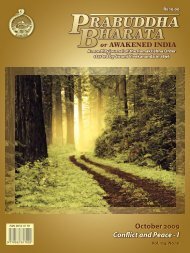October 2011 - Advaita Ashrama
October 2011 - Advaita Ashrama
October 2011 - Advaita Ashrama
Create successful ePaper yourself
Turn your PDF publications into a flip-book with our unique Google optimized e-Paper software.
18<br />
for the validity of the truths claimed by different<br />
religions has universal significance.<br />
3. Separation of Spirituality from Religion<br />
· We have seen that Sri Ramakrishna’s<br />
teaching on direct experience as a principle of<br />
verification has enabled Vedanta to face the<br />
challenges of science and rational thought. This<br />
principle of direct experience also enabled Sri<br />
Ramakrishna to separate spirituality from religion.<br />
By religion is meant a way of life based<br />
on faith in God and moral order; observance of<br />
rituals, customs, and the like; and allegiance to<br />
some institution. Spirituality is a personal quest<br />
for meaning based on a view of the ultimate Reality<br />
and aims at higher fulfilment through direct<br />
mystical experience of the ultimate Reality.<br />
The outer aspects of religion, such as customs<br />
and rituals, show much diversity and are the main<br />
cause of quarrels and conflicts among religions.<br />
The spiritual aspects of the different religions<br />
present a good deal of uniformity. Sri Ramakrishna<br />
held that spirituality forms the most essential<br />
aspect of all religions. When he said that all<br />
religions lead to the same goal, what he meant was<br />
that the spiritual paths of all religions lead to the<br />
same ultimate goal. The separation of the essential<br />
spiritual aspects of religions from their outer<br />
forms that Sri Ramakrishna brought about has<br />
now become a widely accepted view. More and<br />
more people, especially in the West, now regard<br />
themselves as spiritual rather than as religious.<br />
4. Harmony of Religions · Harmony of religions<br />
is a unique and well-known feature of the<br />
spiritual renaissance associated with the avatarahood<br />
of Sri Ramakrishna. No other spiritual or<br />
religious movement in the past had given so<br />
much importance to the doctrine of harmony<br />
of religions. It is true that a general outlook of<br />
religious harmony prevailed in India right from<br />
Vedic times. But it was more of the nature of religious<br />
liberalism and tolerance than a definite<br />
622<br />
Prabuddha Bharata<br />
doctrine based on a metaphysical truth or verified<br />
experience. The oft-quoted Vedic dictum<br />
‘Ekaṁ sad viprā bahudhā vadanti; Truth is one,<br />
sages call it by different names’ in its original<br />
context indicated an identity of divinities, and it<br />
was not so well known until Swami Vivekananda<br />
popularized it as a Vedic authority for the principle<br />
of religious harmony.<br />
In modern times, under the term ‘religious<br />
pluralism’,3 the doctrine of harmony of religions<br />
is being accepted by more and more people all<br />
over the world. It is followed in most of the spiritual<br />
movements that have sprung up in recent<br />
years. In this context two points regarding Sri<br />
Ramakrishna’s concept of harmony of religions<br />
deserve special mention.<br />
In the first place Sri Ramakrishna’s teaching<br />
on harmony of religions is based on direct experience.<br />
We pointed out earlier that every religion<br />
has three levels of function: the social, the intellectual,<br />
and the mystical or spiritual. Most of the<br />
statements on pluralism or harmony of religions<br />
that we come across pertain only to harmony at<br />
the first two levels, namely the social and the intellectual.<br />
Sri Ramakrishna’s message of harmony<br />
of religions emphasizes harmony at the mystical<br />
or spiritual level. He was the only person who actually<br />
practised the spiritual methods of different<br />
religions, gaining thereby the direct experience<br />
that all paths lead to the realization of the same<br />
ultimate Reality, which is known by different<br />
names. Sri Ramakrishna alone attained the harmony<br />
of religions at the experiential level.<br />
The importance of this fact is that pluralism is<br />
a way of deciding the validity of religions. World<br />
religions have different goals. To decide the validity<br />
of religions based on these goals would be<br />
‘religious relativism’, not pluralism. To decide the<br />
validity of any universal phenomenon we need a<br />
fixed standard or unit. To determine distance we<br />
use the fixed unit of metre or foot, to measure<br />
PB <strong>October</strong> <strong>2011</strong>

















